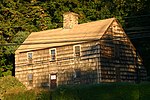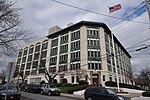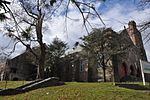Byram School
1925 establishments in ConnecticutBuildings and structures in Greenwich, ConnecticutColonial Revival architecture in ConnecticutNational Register of Historic Places in Fairfield County, ConnecticutSchool buildings completed in 1925 ... and 1 more
School buildings on the National Register of Historic Places in Connecticut

The Byram School is a historic former school building, located between Sherman Avenue and Western Junior Highway in Greenwich, Connecticut. Completed in 1926, it is a well-preserved example of institutional Colonial Revival architecture, enhanced by a parklike setting. It was used as a school until 1978, and was then converted to senior housing. The building was listed on the National Register of Historic Places on August 2, 1990.
Excerpt from the Wikipedia article Byram School (License: CC BY-SA 3.0, Authors, Images).Byram School
Western Junior Highway,
Geographical coordinates (GPS) Address External links Nearby Places Show on map
Geographical coordinates (GPS)
| Latitude | Longitude |
|---|---|
| N 41.012777777778 ° | E -73.653611111111 ° |
Address
Western Junior Highway
06830
Connecticut, United States
Open on Google Maps







